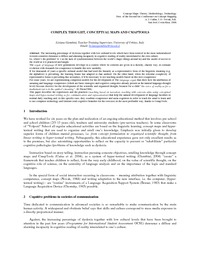Complex Thought, Conceptual Maps And CmapToolsLiviana Giombini
Zu finden in: Second International Conference on Concept Mapping, 2006
 |
 |
 Diese Seite wurde seit 7 Jahren inhaltlich nicht mehr aktualisiert.
Unter Umständen ist sie nicht mehr aktuell.
Diese Seite wurde seit 7 Jahren inhaltlich nicht mehr aktualisiert.
Unter Umständen ist sie nicht mehr aktuell.
 Zusammenfassungen
Zusammenfassungen
 The increasing percentage of dyslexia together with low cultural levels which have been noticed in the most industrialized
western countries denounce a diffuse and alarming incapacity in cognitive reading of reality interrelated to the own culture.
So, where’s the problem? It ‘s in the lack of synchronization between the world’s shape (things around us) and the model of access to
the world as it is practiced and taught.
The organ of language of new generations develops in a context where its contents are given in a sketchy, chaotic way, in constant
evolution with demands for competence to handle this new modality.
If for thousands of years a specific cultural model that had used the linearity as a representative form of the linguistic meaning (e.g.
the alphabets) is prevailing, the learning brains has adapted to that method. On the other hand, when the reticular complexity of
representative forms is prevailing like nowadays, it’ll be necessary to use teaching models based on this new competence
For some years, we are experimenting competent models for the development of The language organ that show how the attribution of
meaning and language competence (which are basic strategies and cognitive categories already present at the natural language-thought
level) become decisive for the development of the scientific and organized thought, because for a child “the voice of reality as for a
mathematician is in the symbol’s meaning”. (R.Thom1988).
This paper describes the experiences and the practices (teaching based on narration, teaching with concrete aims using conceptual
maps and hyper-textual writing as for communication and representation) that help the natural development of language faculties in
normal daily teaching and, in this specific case, they combine competence and meta-cognition in order to teach the mind to learn and
to use computer technology and Internet (real cognitive branches for the own use) in the most profitable way, thanks to CmapTools.
The increasing percentage of dyslexia together with low cultural levels which have been noticed in the most industrialized
western countries denounce a diffuse and alarming incapacity in cognitive reading of reality interrelated to the own culture.
So, where’s the problem? It ‘s in the lack of synchronization between the world’s shape (things around us) and the model of access to
the world as it is practiced and taught.
The organ of language of new generations develops in a context where its contents are given in a sketchy, chaotic way, in constant
evolution with demands for competence to handle this new modality.
If for thousands of years a specific cultural model that had used the linearity as a representative form of the linguistic meaning (e.g.
the alphabets) is prevailing, the learning brains has adapted to that method. On the other hand, when the reticular complexity of
representative forms is prevailing like nowadays, it’ll be necessary to use teaching models based on this new competence
For some years, we are experimenting competent models for the development of The language organ that show how the attribution of
meaning and language competence (which are basic strategies and cognitive categories already present at the natural language-thought
level) become decisive for the development of the scientific and organized thought, because for a child “the voice of reality as for a
mathematician is in the symbol’s meaning”. (R.Thom1988).
This paper describes the experiences and the practices (teaching based on narration, teaching with concrete aims using conceptual
maps and hyper-textual writing as for communication and representation) that help the natural development of language faculties in
normal daily teaching and, in this specific case, they combine competence and meta-cognition in order to teach the mind to learn and
to use computer technology and Internet (real cognitive branches for the own use) in the most profitable way, thanks to CmapTools. Dieses Konferenz-Paper erwähnt ...
Dieses Konferenz-Paper erwähnt ...
 Personen KB IB clear | Mario Arroyo , Alberto J. Cañas , Roger Carff , Rodrigo Carvajal , Noam Chomsky , Richard Dawkins , Thomas Eskridge , Liviana Giombini , Gloria Gómez , D. B. Gowin , Greg Hill , James Lott , Joseph D. Novak , Niranjan Suri | ||||||||||||||||||||||||||||||||||||||||||||||||||||||||||||||||||||||||
 Aussagen KB IB clear | Concept Maps fördern das Lernenconcept maps foster learning | ||||||||||||||||||||||||||||||||||||||||||||||||||||||||||||||||||||||||
 Begriffe KB IB clear |  Cmap Tools
, Concept MapConcept Map
, Concept Mapping SoftwareConcept Mapping Software
, Cmap Tools
, Concept MapConcept Map
, Concept Mapping SoftwareConcept Mapping Software
,  Hypertext Hypertext hypertext
, hypertext
,  Lesekompetenz
, Lesekompetenz
,  Primarschule (1-6) / Grundschule (1-4) Primarschule (1-6) / Grundschule (1-4) primary school
, Schreibenwriting
, primary school
, Schreibenwriting
,  Schule Schule school
, school
,  Sprache Sprache language language
| ||||||||||||||||||||||||||||||||||||||||||||||||||||||||||||||||||||||||
 Bücher |
| ||||||||||||||||||||||||||||||||||||||||||||||||||||||||||||||||||||||||
 Texte |
|
 Dieses Konferenz-Paper erwähnt vermutlich nicht ...
Dieses Konferenz-Paper erwähnt vermutlich nicht ... 
 Nicht erwähnte Begriffe | Kinder, LehrerIn, Unterricht |
 Tagcloud
Tagcloud
 Zitationsgraph
Zitationsgraph
 Zitationsgraph (Beta-Test mit vis.js)
Zitationsgraph (Beta-Test mit vis.js)
 Volltext dieses Dokuments
Volltext dieses Dokuments
 |  Complex Thought, Conceptual Maps And CmapTools: Artikel als Volltext ( Complex Thought, Conceptual Maps And CmapTools: Artikel als Volltext ( : :  , 827 kByte; , 827 kByte;  : :  2021-03-21) 2021-03-21) |
 Anderswo suchen
Anderswo suchen 
 Beat und dieses Konferenz-Paper
Beat und dieses Konferenz-Paper
Beat war Co-Leiter des ICT-Kompetenzzentrums TOP während er Dieses Konferenz-Paper ins Biblionetz aufgenommen hat. Die bisher letzte Bearbeitung erfolgte während seiner Zeit am Institut für Medien und Schule. Beat besitzt kein physisches, aber ein digitales Exemplar. Eine digitale Version ist auf dem Internet verfügbar (s.o.). Es gibt bisher nur wenige Objekte im Biblionetz, die dieses Werk zitieren.












 (
(

 Biblionetz-History
Biblionetz-History